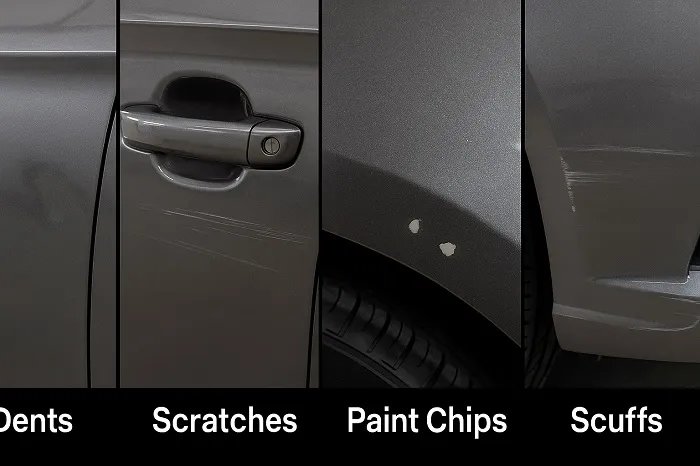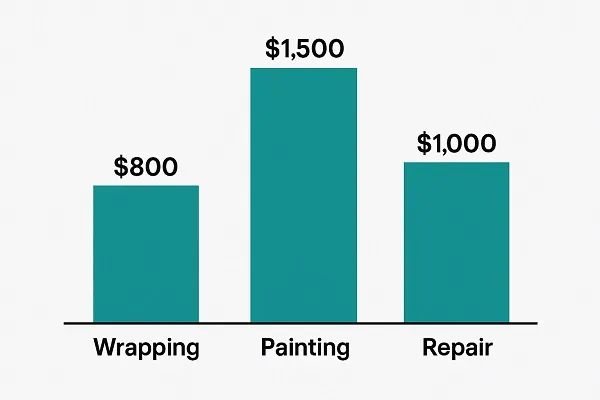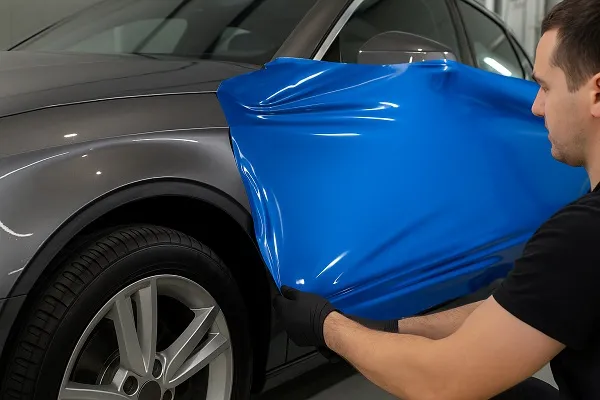Using a vinyl wrap to help hide minor dents or body flaws is a common solution car owners consider when looking for a cost-effective way to improve their vehicle’s appearance. Whether it’s a small door ding, paint blemish, or surface scratch, wraps can offer a temporary or even semi-permanent fix—without a full repaint.
While wraps are not a miracle solution for major damage, they can play a valuable role in disguising imperfections. This article explores how vehicle wraps work, when they are most effective for hiding flaws, and what to consider before wrapping a car with visible damage.
What Are Vehicle Wraps?
A vehicle wrap is a large vinyl decal or graphic applied directly over the paint of a car. It can be used for advertising, personalization, or protection.
Common Types of Wraps:
- Full wrap: Covers the entire vehicle.
- Partial wrap: Covers only certain panels (like the hood or doors).
- Color change wrap: Changes the vehicle’s overall color.
- Printed wrap: Includes graphics, patterns, or branding.
Wraps are typically made of high-quality vinyl, designed to be durable and flexible, conforming to the shape of the vehicle’s body.
Can a Vinyl Wrap Cover Minor Dents or Scratches?
Vinyl wraps can help disguise light imperfections in a car’s body, such as:
- Small dents
- Paint scuffs or chips
- Surface-level scratches
- Faded or oxidized paint spots
Why Wraps Help:
- Visual distraction: Glossy, matte, or textured finishes can draw attention away from dents or flaws.
- Patterned designs: Camo, carbon fiber, or graphic patterns can camouflage irregularities.
- Protective overlay: Wraps create a new surface layer, hiding faded or chipped paint underneath.
However, it’s important to understand that wraps don’t repair the flaw—they only conceal it from plain sight.
What Kinds of Damage Can Be Hidden?

Not all flaws are equally easy to hide. The success of using a wrap depends on the severity and type of the damage.
Ideal Candidates for Wrap Concealment:
- Shallow dents: Especially when there are no sharp creases or broken paint.
- Minor hail damage: Small, consistent dimples across the roof or hood.
- Fine scratches: Those that don’t break through to the primer or metal.
- Peeling clear coat: A wrap can cover inconsistent finishes, although it may need light prep.
Flaws That May Still Show:
- Deep dents or creases
- Rust patches or bubbling paint
- Panels with jagged edges
- Uneven surfaces or filler work
Wrap vinyl conforms closely to the shape of the car. That means any raised or sunken areas might still be visible, especially under glossy finishes or in direct sunlight.
Surface Prep: Crucial for Best Results
Even when hiding flaws, surface preparation is critical. Wrap installers generally prefer a clean, smooth, and stable surface to ensure adhesion and longevity.
Prep Steps May Include:
- Light sanding to level uneven spots
- Applying filler to smooth out deeper imperfections
- Cleaning thoroughly to remove oils, dust, and wax
- Using primer or adhesion promoter on tricky areas
Skipping prep can lead to bubbling, peeling, or wraps that emphasize the flaw rather than disguise it.
Which Wrap Finishes Work Best for Hiding Flaws?
The type of finish you choose plays a huge role in how well imperfections are masked.
Better for Hiding:
- Matte finishes: Absorb light and reduce reflections, minimizing the appearance of dents.
- Satin finishes: Offer a balance of style and concealment without being too shiny.
- Textured wraps: Carbon fiber, brushed metal, or camouflage patterns help mask irregularities visually.
Not Ideal:
- Glossy wraps: Reflective surfaces often make dents and scratches more noticeable.
- Chrome or metallic: Highly reflective and unforgiving to any surface defects.
Choosing the right finish can make or break the final look, especially if the car has visible flaws you’re trying to downplay.
Should You Fix Flaws Before Wrapping?
If the damage is extensive or structural, it’s often best to fix it before wrapping. Vinyl wrap is a cosmetic enhancement—not a body repair solution.
Reasons to Fix First:
- To avoid wraps peeling off uneven surfaces
- To prevent existing damage from worsening under the wrap
- For better resale value and professional appearance
- To meet warranty requirements from wrap installers
That said, for minor dings or faded paint, wrapping can be a great short-term solution—especially for leased cars, marketing vehicles, or older cars not worth a full respray.
Cost Comparison: Wrapping vs. Painting vs. Repair

One of the main reasons people opt for wraps is the lower cost compared to traditional bodywork or painting.
| Solution | Average Cost (USD) | Longevity | Ideal For |
|---|---|---|---|
| Vinyl Wrap | $1,500–$4,000 | 3–7 years | Cosmetic enhancement, quick fix |
| Spot Paint Repair | $300–$1,000+ | Permanent (if done well) | Small sections, color match needed |
| Full Body Respray | $4,000–$10,000+ | Permanent | Complete color overhaul |
| Paintless Dent Repair | $100–$500 per dent | Permanent | Small, shallow dents |
Wraps can be a cost-effective visual upgrade, especially if you want to avoid the expense of paint correction or dent repair on an older vehicle.
Pros and Cons of Using a Wrap to Hide Flaws
Pros:
- Quick visual improvement
- Cost-effective alternative to paint
- Customizable finish and color
- Can protect remaining paint
- Removable if needed
Cons:
- Doesn’t fix the underlying issue
- May still reveal deeper dents under certain light
- Requires prep for best results
- Not suitable for damaged or rusted surfaces
Professional Installation Matters
If you’re wrapping a car with dents or flaws, professional installation is highly recommended. Experienced installers know how to:
- Adjust heat and tension to minimize bubble formation
- Apply extra care around problem areas
- Recommend finishes that help conceal surface issues
DIY wrapping on a flawed surface often leads to poor results, including peeling, bubbling, or stretching of the vinyl.
Is a Wrap the Right Solution for Your Car?
Using a wrap to hide minor dents or body flaws can be a smart and stylish choice—if the imperfections are shallow, stable, and properly prepped. Wraps are not intended to repair damage, but they can make a tired or blemished car look significantly better with the right materials and finishes.
Before deciding, weigh your goals: Do you want to mask the issue temporarily, or invest in a more permanent repair? For many, a vinyl wrap offers the perfect balance of aesthetics, protection, and affordability—especially when covering cosmetic damage that doesn’t require bodywork.

